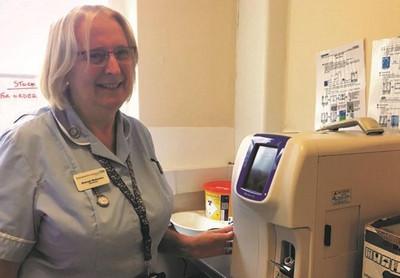Last winter proved an incredibly challenging one for the NHS due to high rates of infectious disease, staffing difficulties from absences and industrial action, as well as capacity constraints due to issues in discharging patients. Consequently, A&E departments and ambulance services in particular faced significant pressures as patients were unable to readily flow through the department.
In December 2022 alone there were 2.3 million A&E attendances and over 101,000 category 1 ambulance responses, which was 20% higher than any previous records. In addition to Urgent & Emergency Care (UEC), Community Services were also under pressure, with 1.5 million people referred to them in November 2022 [1].
Winter planning
As winter approaches this year, the NHS is now bracing for another facing the possibility of higher than usual levels of respiratory illness including COVID, flu and RSV. This is based on data from Australia, which often provides a predictor as to the likely winter experiences of the NHS. Australia has seen one of its biggest flu seasons on record, with children particularly affected [2].
That said, given 2022 experiences, the NHS has already been seeking to address these challenges. In January 2023 it published a UEC Recovery Plan which aims to ensure patients are seen more quickly in emergency departments, with a target of admitting, transferring or discharging 76% within 4 hours by March 2024, as well as a focus on improving ambulance response times [3]. As also highlighted by the recently published 2023/24 NHS Winter Plan, the UEC recovery plan is fundamental to the improvement of patient throughput and discharge [4].
Care outside hospital
In addition to improving flow of patients through A&E and seeing people faster when they go to hospital, another means of improving pressures and cutting waiting times in UEC is to prevent visits in the first case by expanding care outside the hospital. This can enhance patient experience and avoid unnecessary admissions, so the NHS is looking at joining up new types of care outside hospital and expanding virtual wards [5].
Virtual wards can bridge the gap between hospitals and patients’ homes, enabling patients to remain in the comfort of their own home supported by family or carers. Notably, up to 20% of emergency admissions are potentially avoidable with the right care in place [5].
The key role of diagnostics
As 85% of clinical pathways rely on diagnostics, it must underpin many of these aforementioned targets and changing pathways. So, given the need for rapid clinical decision making to ensure correct patient pathways and improved outcomes in all of these scenarios, in vitro diagnostics (IVD) at the point of need is increasingly required. Consequently, NHS England has recently published new guidance on integrating point-of-care testing (POCT) into urgent community response and virtual ward services, crucially under the remit of pathology departments to ensure results quality and safety [6,7].
The importance of the involvement of trained biomedical scientists in POCT implementation has also been highlighted in recent POCT guidance [7]. This guidance affirms that diagnostic testing, regardless of setting, should remain within the expert domain of pathology departments. Thus, ensuring that high quality POCT is delivered within an accreditable framework.
POCT can support rapid clinical decision making in the community, particularly where it is not clear from standardised assessments whether a patient should be conveyed to hospital, treated on scene, admitted to a virtual ward or discharged to primary care. For example, sepsis and dehydration can present in a similar way, if sepsis can be ruled out rapidly by using POCT, then unnecessary hospital conveyance and admission can be prevented.
CRP (C-Reactive Protein) is a widely used inflammatory biomarker which alongside haematology data can be used to help clinicians determine the degree of inflammation/infection in various disease processes, including sepsis, to stratify risk (Figure 1). These data can essentially catch and differentiate viral or bacterial infections earlier and determine the best clinical pathway at the POC, which can also support antimicrobial stewardship. Consequently, rapid POC CRP with haematology testing can optimise triage management in the community, or at the front door of an Emergency Department (ED), to support prompt stratification of high from low-risk cases.

Figure 1: CRP as an inflammatory biomarker, rises after about 12–36 hours of an illness and can reach high levels if the illness goes untreated. It rises with viral, bacterial and fungal infections and inflammatory processes such as rheumatoid arthritis.
POCT haematology and CRP
Celebrating its 70th anniversary in 2023, HORIBA holds considerable understanding and expertise in CRP and haematology testing with 5-part differential at the POC. There are many examples of the application of its POC analysers enabling rapid clinical decisions in both EDs and the community to improve flow or change patient pathways which have been published in recent years [8]. These include community and UEC locations across Cornwall [9] and EDs such as Guys & St Thomas’s Hospital Paediatric ED [10].
In addition, within the recent NHS POCT guidance a case study-led publication from Oxford AHSN was highlighted and referenced [11]. Within this, the successful implementation of HORIBA’s Microsemi CRP and Yumizen H500 (Figure 2) compact haematology analysers in various POCT locations were discussed.

Figure 2: HORIBA’s award winning Yumizen H500 compact benchtop haematology analyser can deliver 5-part differential POC results in a variety of locations
The Yumizen H500 has recently won a Scientist’s Choice Award in recognition of its diagnostics value to clinical scientists and clinicians for ensuring safe and easy diagnosis by providing timely and reliable haematology results in many locations. Requiring just two reagents to deliver a full blood count (FBC) in one minute, this also makes it a sustainable option. Plus, with an intuitive touchscreen user interface, it is designed for genuine ease-of-use at the POC by non-specialist staff. Yet, it offers 37 parameters, including: full 5-part white blood cell (WBC) differential, immature WBCs, digital red blood cell parameters, and platelet parameters.
Similarly, the Microsemi CRP has proven an invaluable tool in many POCT locations as it offers simultaneous blood analysis with CRP measurement within four minutes, making it ideal for patient triage and supporting immediate near-patient treatment decisions. Its whole blood micro-sampling of just 10µL for FBC with 3-part differential, and 18µL for FBC+CRP delivers lab accurate results, even for small paediatric samples. The new Microsemi CRP LC-767G at just 30 cm wide, is highly compact, robust and user-friendly, enabling the location of this dual-purpose system anywhere required.
Reducing unnecessary admissions
Studies by Oxford AHSN have confirmed that deployment of the Microsemi CRP analyser (Figure 3) can streamline existing diagnostic pathways and improve patient flow through busy UEC hospital departments due to its rapid determination of a patient’s combined FBC and CRP result without having to wait for lab results [11].

Figure 3: HORIBA’s Microsemi CRP benchtop POC haematology analyser in action at the Marlow Community Hospital, supporting the Frailty Assessment Hub located there.
In addition, the value of use in primary care of the Microsemi CRP has been demonstrated within a busy GP group practice. Using the Microsemi CRP, the Brookside Group Practice (Lower Earley, Berkshire) aimed to relieve winter flu pressures and meet requirements to reduce unnecessary hospital visits and admissions. Its results demonstrated tangible benefits for urgent care clinical decision making and cost savings [12].
The Yumizen H500 with its 5-part differential has also been highlighted as a suitable near-patient testing tool which can help to keep patients out of main hospitals [11]. Located in many UEC and community settings, it can be used to speed up decision making and improve patient pathways.
Supporting winter resilience
Accurate and effective POCT operated by multidisciplinary healthcare teams offers timely access to diagnostics outside of acute hospitals, which is essential for supporting UK Government targets to alleviate pressures on UEC settings and hence reduce waiting times. This in turn can boost the winter operational resilience of the NHS.
Rapid diagnostics can optimise triage management, which not only supports and raises confidence in clinical decisions to improve patient flow and outcomes, but also reduces unnecessary conveyance and admissions to hospital, as well as accelerating discharge. Prompt POCT results can also importantly aid better antibiotic prescribing and antimicrobial stewardship.
References
- NHS Providers (2023). The Provider Podcast: Winter Watch – Wrapping Up. Released 16 March 2023. nhsproviders.org/resources/provider-bites/the-provider-podcast-winter-watch-wrapping-up
- NHS England (2023). NHS sets out plans for winter with new measures to help speed up discharge for patients and improve care. Published 27 July 2023. www.england.nhs.uk/2023/07/nhs-sets-out-plans-for-winter-with-new-measures-to-help-speed-up-discharge-for-patients-and-improve-care/
- NHS England (2023). Delivery plan for recovering urgent and emergency care services. Published 30 January 2023. www.england.nhs.uk/publication/delivery-plan-for-recovering-urgent-and-emergency-care-services/
- NHS England (2023). Winter Plan – 2023/24. Published 27 July 2023. www.england.nhs.uk/long-read/winter-plan-2023-24/
- NHS England (2023). Expanding care outside hospital. NHS Impact. Accessed 29 September 2023. www.england.nhs.uk/nhsimpact/integrated-urgent-and-emergency-care-improvement/expanding-care-outside-hospital/
- NHS England (2023). Integrating in vitro point of care diagnostics: guidance for urgent community response and virtual ward services. Published 29 August 2023. www.england.nhs.uk/publication/integrating-in-vitro-point-of-care-diagnostics-guidance-for-urgent-community-response-and-virtual-ward-services/
- The Association of Clinical Biochemistry & Laboratory Medicine, The Institute of Biomedical Science, The Royal College of Pathologists (2023). Point of Care Testing: National Strategic Guidance for at Point of Need Testing. Published 25th May 2023. www.rcpath.org/discover-pathology/news/new-strategy-for-point-of-care-testing-published.html
- Pathology in Practice (2022). How can POCT help to alleviate NHS winter pressures? 15-17, December 2022. www.pathologyinpractice.com/story/40234/how-can-poct-help-to-alleviate-nhs-winter-pressures
- Campbell M (2020). Role of POC CRP during the pandemic. Clinical Services Journal, p65-67, August 2020. www.clinicalservicesjournal.com/story/33504/role-of-poc-crp-during-the-pandemic
- POCT Innovators (2022). Improving healthcare services with POCT. poctinnovators.com/improving-healthcare-services-with-poct/
- Hart J, Oxford Academic Health Science Network (2021). Opportunities for point of care testing. www.oxfordahsn.org/wp-content/uploads/2021/10/AHSN-point-of-care-final.pdf
- Checketts G et al, Oxford Academic Health Science Network (2020). Introducing point of care (POC) testing in a primary care urgent care pathway to improve clinical service delivery. www.oxfordahsn.org/wp-content/uploads/2020/11/Use-of-POC-testing-in-a-GP-Urgent-Care-Pathway-Report-Final-22-10-20.pdf